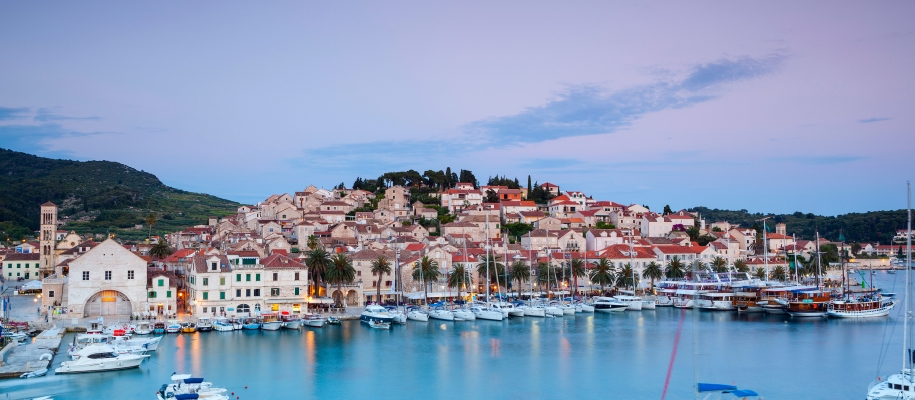A beautiful fragrant island off of the coast of Croatia in the southern Adriatic Sea. unusual for an island of this location as it has large coastal plains and freshwater springs but in contrast, it has sharply rising dolomite and limestone ridges covered in lavender and rosemary. There are roughly 10 villages on the island and many little bays with a few campsites, the main port town of the island is also called Hvar situated on the most westerly tip it is a rambling oldy-world place with a 13th-century hilltop fortress and walls, in the towns main square you will find the beautiful renaissance Cathedral. Ferries go from here to the mainland of Croatia also across the narrow Adriatic to Italy and to some of the other Croatian Islands nearby. Historically because of the geography of the island it was a perfect stop off for much of the trade that passed giving the island a moderate amount of prosperity and industry. Way before this time there have been excavations proving that the island was inhabited as far back as the Neolithic era, and the ancient Greeks founded the northern town of Stari Grad making it one of the oldest towns in Europe, unfortunately, the prosperity took a blow at the beginning of the 20th century as one of the main industries, boat building was hit hard as wooden boats were replaced by steel and the islands other biggest export, wine was hit by a huge phylloxera infestation which devested the crops many islanders left at this time to make a new life elsewhere and today the populatiın of the islands stands at just over 11 thousand, the main source of income today is tourism and it is flourishing . not surprising as the island of Hvar is simply beautiful. Hvar is also the stepping stone island that leads on to the pretty dotted smaller Paklinski Islands.
Typically most of the Islands of this region have a very moderate climate with warm long dry summers and short wet winters.
A beautiful fragrant island off of the coast of Croatia in the southern Adriatic Sea. unusual for an island of this location as it has large coastal plains and freshwater springs but in contrast, it has sharply rising dolomite and limestone ridges covered in lavender and rosemary. There are roughly 10 villages on the island and many little bays with a few campsites, the main port town of the island is also called Hvar situated on the most westerly tip it is a rambling oldy-world place with a 13th-century hilltop fortress and walls, in the towns main square you will find the beautiful renaissance Cathedral. Ferries go from here to the mainland of Croatia also across the narrow Adriatic to Italy and to some of the other Croatian Islands nearby. Historically because of the geography of the island it was a perfect stop off for much of the trade that passed giving the island a moderate amount of prosperity and industry. Way before this time there have been excavations proving that the island was inhabited as far back as the Neolithic era, and the ancient Greeks founded the northern town of Stari Grad making it one of the oldest towns in Europe, unfortunately, the prosperity took a blow at the beginning of the 20th century as one of the main industries, boat building was hit hard as wooden boats were replaced by steel and the islands other biggest export, wine was hit by a huge phylloxera infestation which devested the crops many islanders left at this time to make a new life elsewhere and today the populatiın of the islands stands at just over 11 thousand, the main source of income today is tourism and it is flourishing . not surprising as the island of Hvar is simply beautiful. Hvar is also the stepping stone island that leads on to the pretty dotted smaller Paklinski Islands.
Typically most of the Islands of this region have a very moderate climate with warm long dry summers and short wet winters.
Hvar is a great destination point if you also want to visit the nearby islands of Mljet, Korcula and the Paklinski Islands.










